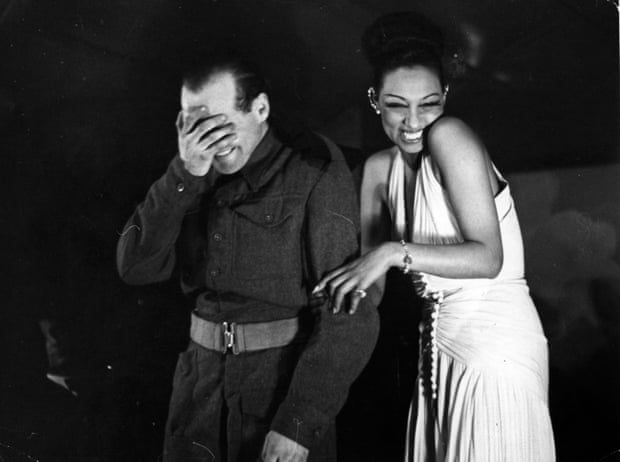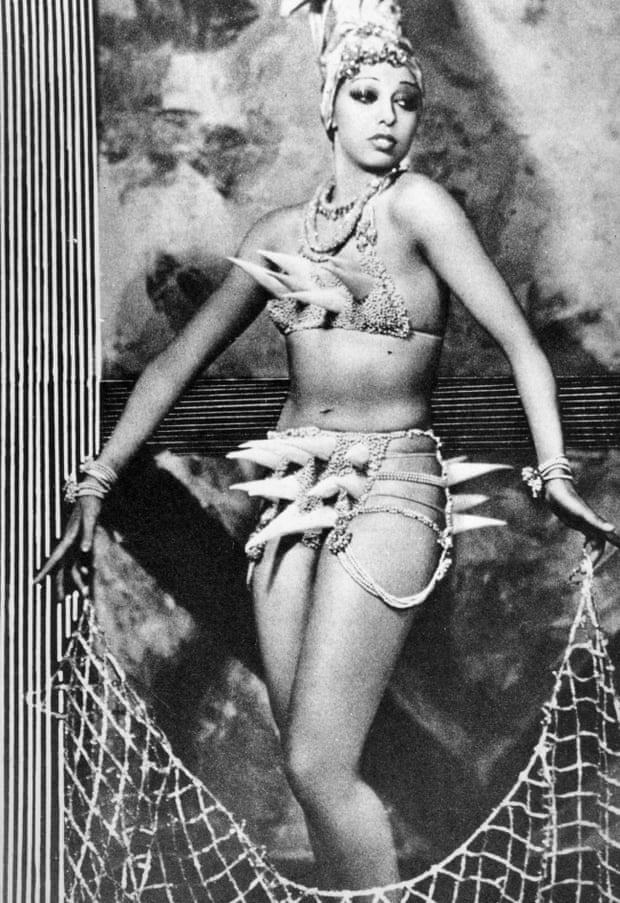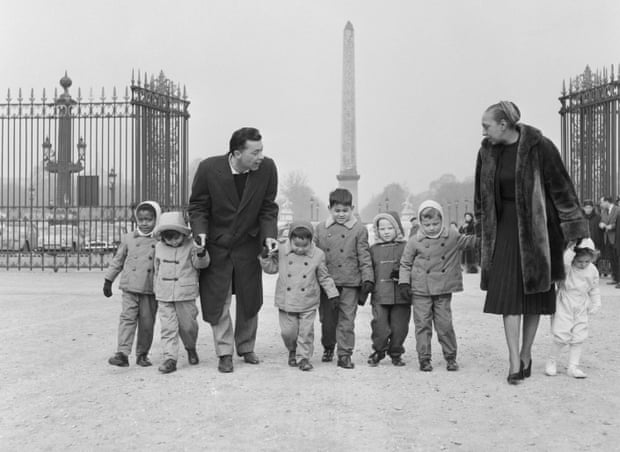Dancer, singer … spy: France’s Panthéon to honour Josephine Baker
The performer will be the first Black woman to enter the mausoleum, in recognition of her wartime work

The information was mostly written on the singer’s musical scores in invisible ink, to be revealed with lemon juice. The photographs she had hidden in her underwear. The whole package was handed to British agents at the Lisbon embassy – who informed Abtey and Baker they would be far more valuable assets in France than in London.
So back to occupied France Baker duly went. “She was immensely brave, and utterly committed,” Hanna Diamond, a Cardiff university professor, said of Baker, who on Tuesday will become the first Black woman to enter the Panthéon in Paris, the mausoleum for France’s “great men”.
Born Freda Josephine McDonald in St Louis in 1906, Baker left school at 12 and landed a place in one of the first all-Black musicals on Broadway in 1921. Like many Black American artists at the time, she moved to France to escape discrimination.

Emerging from the chorus line of La Revue Nègre, she became a huge star, tapping into colonialist, racist and male sexist fantasies in performances that both shocked and delighted audiences and won admirers from Ernest Hemingway to Pablo Picasso.
Dubbed “the Black Venus”, she danced the charleston in nothing but a string of pearls and a skirt made of 16 rubber bananas, performed with a snake wrapped suggestively round her neck, strolled down the Champs-Élysées with her pet cheetah, and became an international superstar.
Off stage, as the hit songs and starring movie roles succeeded one another, Baker cultivated a scandalous private life, having affairs with men and women including the novelist Colette, the architect Le Corbusier and the crown prince of Sweden.
After the war she fought for equal rights as energetically in public as at home, speaking before Martin Luther King at the 1963 March on Washington and adopting 12 children from around the world to live with her in her chateau in the Dordogne.

Her wartime spying activities, however, are – for obvious reasons – rather less reliably documented

Publié le 2021-11-26 | lenouvelliste.com
Joséphine Baker, artiste engagée
 Freda Josephine McDonald, connue sous le nom de Joséphine Baker (1906 – 1975) est une chanteuse, danseuse, actrice et meneuse de revue. Militante et membre de la résistance pendant la Seconde Guerre mondiale, elle s’est engagée dans la lutte contre le racism.
Freda Josephine McDonald, connue sous le nom de Joséphine Baker (1906 – 1975) est une chanteuse, danseuse, actrice et meneuse de revue. Militante et membre de la résistance pendant la Seconde Guerre mondiale, elle s’est engagée dans la lutte contre le racism.
En 1927, après une tournée en Europe, Joséphine mène la revue aux Folies Bergères. Elle est accompagnée sur scène d’un léopard, Chiquita, qui s’échappe fréquemment dans la fosse, terrorisant les musiciens et excitant le public. La même année, elle se lance dans la chanson et le cinéma. Sa célèbre chanson « J’ai deux amours » rencontre le succès en 1931 tandis que les films dans lesquels elle joue, Zouzou et Princesse Tam Tam, ont moins d’audience. Elle inspire les artistes de son époque, parmi lesquels Ernest Hemingway, F. Scott Fitzgerald, Pablo Picasso et Christian Dior. En 1934, elle chante l’opéra de Jacques Offenbach La créole et, à cette occasion, travaille sur sa voix et progresse considérablement en chant. En 1936, Joséphine Baker repart aux États-Unis pour une tournée mais elle ne bénéficie pas du même succès qu’en Europe et subit le feu des critiques. Elle rentre en France l’année suivante, blessée par cet accueil. En 1937, elle épouse Jean Lion et acquiert la nationalité française.
La « tribu arc-en-ciel »
 En 1939, lorsque la Seconde Guerre mondiale éclate, Joséphine Baker est recrutée par le Deuxième Bureau, service de renseignements de l’armée française. Son travail lui permet en effet de se déplacer fréquemment et de transmettre des informations sans attirer l’attention. Grâce à ses fréquentations, elle collecte des informations auprès la haute société parisienne, se mobilise pour la Croix-Rouge et fait passer des messages à l’encre invisible sur ses partitions. En 1941, elle s’installe à Casablanca où elle tombe gravement malade pendant de longs mois. A partir de 1943, elle se met à chanter pour les soldats français, britanniques et américains en Afrique du nord. Au cours de la Libération, elle se produit pour les soldats et résistants en suivant la ligne de front. Après la guerre, ses activités lui valent la croix de guerre, la Médaille de la résistance et la Légion d’honneur des mains du Général de Gaulle.
En 1939, lorsque la Seconde Guerre mondiale éclate, Joséphine Baker est recrutée par le Deuxième Bureau, service de renseignements de l’armée française. Son travail lui permet en effet de se déplacer fréquemment et de transmettre des informations sans attirer l’attention. Grâce à ses fréquentations, elle collecte des informations auprès la haute société parisienne, se mobilise pour la Croix-Rouge et fait passer des messages à l’encre invisible sur ses partitions. En 1941, elle s’installe à Casablanca où elle tombe gravement malade pendant de longs mois. A partir de 1943, elle se met à chanter pour les soldats français, britanniques et américains en Afrique du nord. Au cours de la Libération, elle se produit pour les soldats et résistants en suivant la ligne de front. Après la guerre, ses activités lui valent la croix de guerre, la Médaille de la résistance et la Légion d’honneur des mains du Général de Gaulle.
En 1947, Joséphine Baker épouse Jo Bouillon et achète avec lui le domaine des Milandes en Dordogne. Suite à une fausse couche, elle ne peut avoir de bébés mais, en 1949, elle décide d’adopter des enfants de toutes les origines (sa « tribu arc-en-ciel ») pour prouver que des enfants de différentes religions et de différentes ethnicités peuvent être frères et sœurs. Elle élève ainsi deux filles et dix fils originaires du monde enter. . .
Le mouvement afro-américain des droits civiques
Dans les années 1950, elle soutient le Mouvement afro-américain des droits civiques, écrivant des articles et donnant des interventions pour dénoncer le racisme et la ségrégation aux Etats-Unis. En 1955, elle relaie en Europe le scandale par le meurtre d’Emmet Till et par l’acquittement des deux assassins. En 1963, elle participe à la Marche vers Washington pour le travail et la liberté organisée par Martin Luther King. ; elle intervient à ses côtés et y rend hommage aux activistes Rosa Parks et Daisy Bates.
Joséphine Baker continue à se produire, à l’Olympia de Paris en 1968, à Belgrade en 1973, à Carnegie Hall en 1973, au Royal Variety Performance au Palladium de Londres en 1974, au Gala du cirque en 1974 à Paris. En 1975, elle réalise une rétrospective de sa carrière, « Joséphine à Bobino ».
Le 10 avril 1975, Joséphine Baker est victime d’une attaque cérébrale. Transportée à l’hôpital, elle y meurt deux jours plus tard à 69 ans


No comments:
Post a Comment